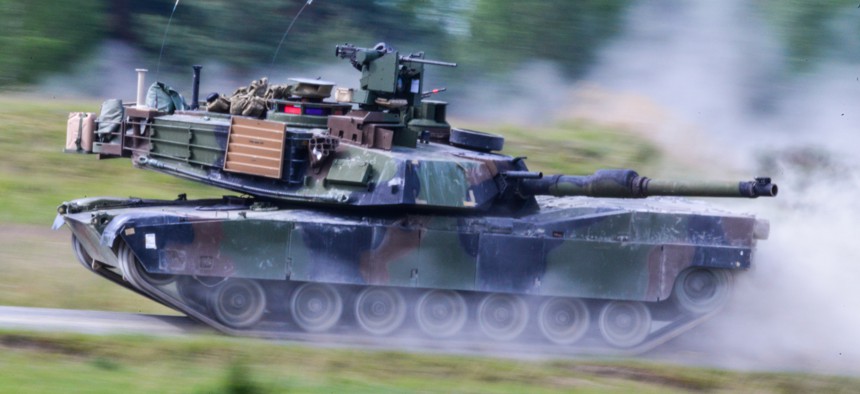
A 2016 photo of a 3rd Infantry Division tank at the 7th Army Joint Multinational Training Command's Grafenwoehr Training Area, Grafenwoehr, Germany. U.S. Army / Pfc. Javon Spence
Is the Pentagon Truly Committed to the National Defense Strategy?
Various warning signs say "no." The 2020 budget will tell. Congress must scrutinize it carefully.
As Senate and House committees examine the Trump administration’s proposed defense budget for fiscal 2020 — it totales three-quarters of a trillion dollars — the first and most important question they should ask is: Does this budget decisively improve the U.S. posture for great-power competition with China and Russia?
The 2018 National Defense Strategy developed under the leadership of Secretary James Mattis made clear the need to prioritize major improvements in the U.S. ability to deter Chinese or Russian aggression. In particular, it aimed our armed forces at defeating Chinese and Russian theories of victory, especially any efforts to rapidly create a fait accompli — for example, a Chinese invasion of Taiwan or a Russian invasion of the Baltics—which would likely be the most stressing armed aggression Beijing or Moscow might attempt.
Crucially, the NDS’ shift toward great-power competition enjoys strong bipartisan support, reflected in its endorsement by the National Defense Strategy Commission, a group of distinguished former officials and experts from both parties chartered by Congress to review the Strategy. This is no coincidence. Indeed, the NDS builds on much of the momentum and intellectual capital developed during the latter part of the Obama administration, especially in the Pentagon’s so-called Third Offset Strategy. The need for a shift away from nearly two decades of focus on counterinsurgency operations to great-power competition is clear, and it is not a partisan issue.
Broad agreement across the parties on the direction of the U.S. military may seem unlikely in these partisan days, and it must not be squandered. The American military, while still the envy of the world, has seen its edge against China and Russia erode substantially over the last two decades, as the nation focused on counterinsurgency operations and as the Budget Control Act took what former Secretary of Defense Leon Panetta termed a “meat ax” approach to defense spending. The United States has catching up to do, particularly in its ability to help deter intimidation and if necessary defeat armed aggression against the most vulnerable members of the U.S. alliance architecture in the Western Pacific and Eastern Europe. Moreover, the trend lines are not good; without substantial focus on reversing them, this deterioration could continue, making crisis and war more likely.
Related: 2020 Budget Request Reveals Slow Shift Toward Great Power War
Consequently, the United States military must prioritize restoring its edge in warfighting ability in those strategically significant, plausible scenarios. The goal is to deter aggression and prevent war, not to provoke them. This prioritization does not mean ignoring other threats, like North Korea and international terrorism. The United States requires a robust national missile defense against North Korea; and we must keep the pressure on organizations like ISIS and al Qaeda. Rather, this prioritization means that we must find more cost-effective and sustainable ways of operating in the Middle East and globally while reallocating resources to rapidly develop and field advanced military capabilities that will better deter and if necessary defeat any Chinese attack on, say, Taiwan, or any Russia attack on the Baltic states or other NATO allies.
Fortunately, the Department of Defense has recognized the need to make this shift. What remains to be seen in the Department’s budget submission is whether DOD is putting its money where its strategy is. The National Defense Strategy Commission, which was granted unprecedented access to the Department, judged just a couple of months ago that DOD did not have a coherent or clear approach to implementing the NDS. Moreover, recent reports suggest that other Departmental guidance documents that should advance the implementation of the NDS, including the Chairman’s National Military Strategy, do not in fact align with it. The NDS must not be just a fig-leaf cover for other approaches; it is supposed to be a plan to drive change urgently and at scale. Consequently, all of the Department, from top to bottom, should strive to genuinely apply the clear logic the NDS sets out to the full range of DOD activities.
In addition, some senior leaders of the military departments have made clear their desire for more force structure: more tactical squadrons for the Air Force, more ships for the Navy, and more troops for the Army. If the NDS were followed, as Secretary Mattis repeatedly made clear, the focus would be on quality (capability) over quantity (capacity), not the other way around. Coupled with the Commission’s warning about the decline in influence of senior civilian officials, these expressed priorities should cause serious worry about the Department’s commitment to implementing the NDS.
This is cause for serious concern. Our forces’ warfighting edge has already diminished, and neither China nor Russia is standing still. If China or Russia judge aggression or coercion to be the best option, crisis or war could happen. The NDS directs a clear shift toward improving the Joint Force’s warfighting ability against China or Russia – precisely in order to most effectively prevent war from happening. The Strategy must be implemented with urgency, and the time to do so is now.



